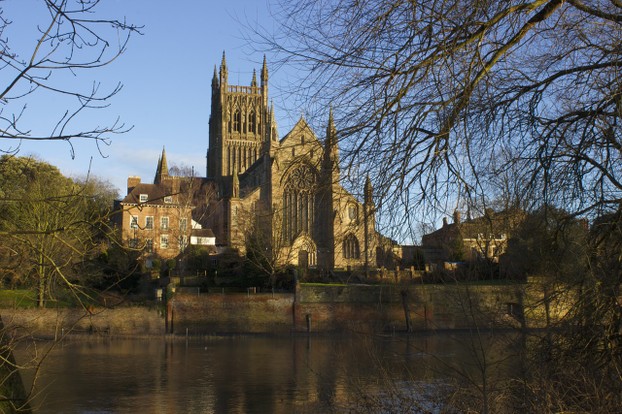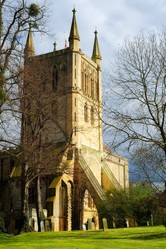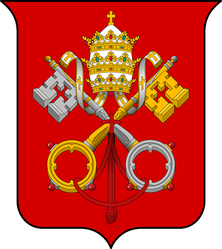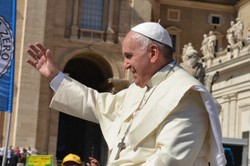The city of Worcester stands on the Avon, which flows down to the powerful Severn, surging southwards from the Welsh hills.Overlooking the river is Worcester Cathedral, an imposing edifice of stone. The cathedral as you see it now was a Norman construction, and Worcester's most famous son had a simpler building that was replaced after the Norman conquest. Bishop Wulfstan was less interested in stone buildings than he was in the true foundations of the church, its people, and he was committed to the church's mission to the poor and the needy.
The great-nephew of Archishop Wulfstan of York, [also a saint] who was dead before Wulstan became a bishop, the young Wulfstan, who was born in 1008, studied at the abbeys of Evesham [near Worcester] and Peterborough. He then became a clerk at Worcester cathedral, which meant that he was a minor cleric given to routine administrative duties. But his diligence in his duties and his chastity [he actually kept the celibacy rules and did not have a mistress or frequent brothels, as some clerics did] got him noticed and the bishop asked him to become a priest. He was ordained priest and later joined the Benedictine order in their abbey near Worcester,where his talents led him upwards first to the rank of novice master, supervising young monk, but next to he was promoted to prior,the assistant to the abbot.
By 1062 a problem had developed. Bishop Eadfrith was in trouble with the Pope. Eadfrith, who does not seem a bad guy, was guilty being bishop not only of Worcester, but also archbishop of York, besides having several other income streams. It is against church rules for a bishop to rule two dioceses and so Pope Nicholas the Second laid the law down. Drop one, so he was forced to step down from Worcester. Why did Eadfrith have two bishoprics? Easy, the trick was to have a few of them, get the revenues, appoint an underpaid, but devoted monk as suffragen/auxiliary bishop and then enjoy the profits. Wulfstan got the job and decided to run the diocese properly.
Then there came a problem. Strictly speaking Wulfstan should have been consecrated by his superior, Stigand of Canterbury, but Wulstan knew that Stigand had been uncanonically appointed [without papal consent] so he not only refused to be consecrated by him, but would not swear obedience, though he was happy to be consecrated by Eadfrith, by then safely at York, and later to swear obedience to Lanfranc,the Norman who succeeded Stigand at Canterbury.
Then in 1066 the Norman conquered England and most Saxon bishops were deposed, but Wulfstan was spared, as William the conqueror recognized a genunely good and holy man and an outstanding bishop. What helped Wulfstan's cause is that he was the first bishop to do homage to William. He was also willing to work well with Lanfranc.









 Pilgrimage. A review25 days ago
Pilgrimage. A review25 days ago
 Leo the Fourteenthon 05/09/2025
Leo the Fourteenthon 05/09/2025
 The Melsonby Hoardon 03/25/2025
The Melsonby Hoardon 03/25/2025



Comments
I do not know. There could be? He is still revered in Worcester.
The second paragraph to the first subheading, Early life, associates the subsequent St. Wulfstan with the Benedictine order.
Does that mean that there may be such a thing as a St. Wulfstan honorary garden?
You have scientific proof of our genome, but as I have said previously, the historical interpretation of the data is to my mind questionable. English is not a single set of genes, but a complex interaction of various genetic inputs going back to the post Ice Age period. The composition, according to Oppenheimer, is three post ice age groups followed by some other inputs over the generations [including a neolithic input that brought farming.] The Anglo-Saxons followed, but they were South Scandinavians who contributed merely no more than ten per cent of the English gene pool. Then came the Danes and in Lancashire Norwegians. So English is a composite race containing much Scandinavian. The Angles and Jutes were both from Denmark and their language was close to Danish.Your Scandinavian could merely be Angle, or Danish though you have ancestors from Limerick, where the Scandinavian [Norwegian] input was strong
Personally, I have never had my Y chromosome tested [not worth spending the cash on it] so I don't know whether my Y chromosome is Anglo-Saxon or ancient British, for we are a family from Lancashire, where pre-Saxon British survived in significant numbers.
Exactly : you estimate. I have scientific laboratory proof. Of course, we are the same but different You inherit the English Y chromosome from dad and his dad and his dad ......which I don't have as I got his Irish X from his mother.
Genetics is a fascinating field.
Well, Veronica, I estimated it from where various ancestors originated. I am unsure of the precise mix, as the further back you go the more complex the mix becomes. When you read the history of these isles you see just how intermingled the nations are. I have pointed out before that English and Irish nationality both include Scandinavian ancestry. If you read Beowulf and Grendell, by Grigsby, you will see that the Angles, Saxons and Jutes counted as South Scandinavians rather than as Germans. English is not as some think a simple, mono-ethnic nationality, but from the beginning has been an ethic mixture.
Wulfstan is a much loved folk memory in Worcestershire, but I am unsure whether there is a hospitl in his name. The British National Health Service has undergone so much re-organizaton, with institutions changing names as they are amalgamated that it is hard to keep up with it all. Normally, hospitals would be named according to the health trust to which they belong.
In the Sixteenth Century Wulfstan's institution was sold to the Wilde family, who closed it and used the building for their own purposes.An ancient noble family, they still own an estate in the West Midlands, but I do not think that they still own Wulfstan's site, which was sold on.
Well written, and now your words have traveled throughout the world. Spreading information that is otherwise obscure is the power of Wizzley.
frankbeswick, Has there been a hospital built to honor the one that Saint Wulfstan had constructed in 1085 and that was dismantled in the sixteenth century? Was his hospital destroyed or re-purposed?
I am not near equal measures at all. I don't know where you get that from .I am nearly 60% Irish and only 13% English. according to my DNA , I am 15% Scandinavian which is my second ethnicity.
Katie, many in Britain are mixed like you are. I and Veronica have roughly equal amounts of English and Irish.